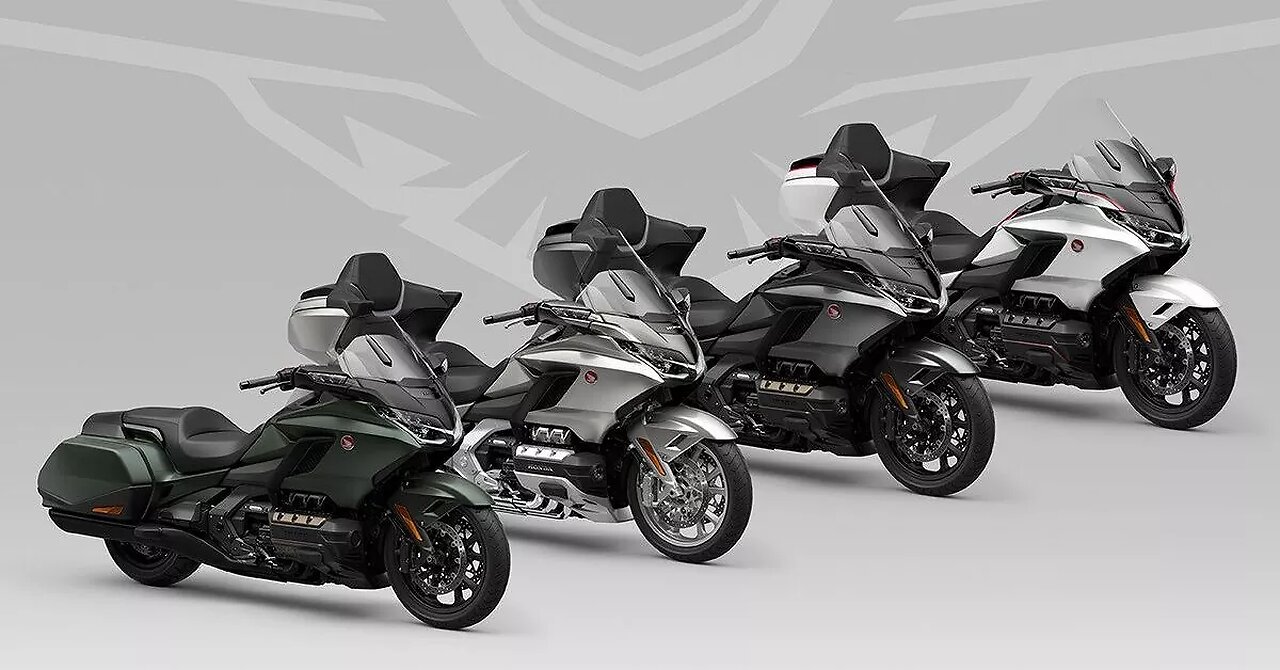Premium Only Content

HONDA GOLD WING 2024| Things You Need To Know before buying
You would be hard-pressed to find a better touring motorcycle than the Honda Gold Wing. Constructed for maximum comfort, the owners of this opulent Japanese two-wheeled barge treasure it for its ability to expedite even the most arduous journeys. The Gold Wing allows you to travel the road in a capable, strong, and relaxed vehicle.
OVERVIEW
The Gold Wing is a legendary name in the world of motorcycles, and for very good reasons. It's not just about its almost fifty-year history or the significant impact it has had. What truly sets the Gold Wing apart is its exceptional performance in every aspect. From its refined design to its impressive speed, outstanding handling, and a flat six-cylinder engine that rivals even a Porsche.
The Gold Wing has a rich history that spans nearly five decades, with the engine evolving through six generations of development. It started with a 999cc eight-valve flat four-cylinder in 1975 and eventually grew to a 1,832cc 24-valve flat six-cylinder powerplant in 2018. Surprisingly, the original Gold Wing didn't even have a fairing or hard luggage. It wasn't until the Gold Wing Interstate model was introduced in 1980 that the Wing became what it is known for today. Before that, owners had to rely on aftermarket accessories, hoping not to compromise what Honda had perfected. In 1978, CW added various touring accessories to its long-term Wing, adding 75 extra pounds. When fully loaded, it came close to the load capacity of the OE tires, making it a risky endeavor.
Honda was smart to equip later Gold Wings with every feature and accessory a rider could desire. The 1975 model weighed 584 pounds dry, but by 1987, the first flat-six-engined Gold Wing was just under 800 pounds dry. Despite its weight, the Gold Wing has always been remarkably agile, thanks in part to the transmission being positioned under the crankshaft to maintain a low center of mass.
Honda made waves in 2018 with the release of the sixth-generation GL1800, boasting a more powerful four-valve per cylinder engine, a new die-cast twin-spar aluminum frame, a double-wishbone Hossack-type front suspension, and the latest electronic rider aids and convenience features. Not only that, but Honda also managed to shed 90 pounds from the bike and make it more compact.
The Gold Wing sets the benchmark for long-distance, two-up motorcycle touring. It's not just incredibly comfortable, but its performance is truly remarkable. It conquers winding roads effortlessly, smoothly navigating from curve to curve. Despite being six years old, the latest update keeps the Wing feeling modern and innovative.
Highs & Lows
The latest Gold Wing is truly a masterpiece of luxury touring, offering unparalleled comfort and capability. The Automatic DCT transmission delivers astonishing precision. Thanks to the Hossack-style front suspension, the Gold Wing handles corners with agility, defying its hefty weight of over 800 pounds.
The smaller design of the gen-six Wing results in reduced luggage space. Oddly shaped side cases exacerbate the issue. The absence of adaptive cruise control and blind spot detection highlights how technology has advanced since its debut in 2018. It is bulkier and less powerful compared to its rivals.
Key Features
Key Features of this Luxury Japanese Bike are:
-The Flat Six Engine
-The Seven Speed DCT Transmission is now Standard on Most Trims
-Road Going Chassis
-Throttle by Wire
-Hill Start Assist
-Advanced Technology
-Ample Storage for the Goldwing Crowd
-Integrated Starter Generator and Idling Stop
-Improved Passenger Comfort
-Walking Mode
-Nano-Tech Paint
Prices and Options
The Gold Wing and Gold Wing Tour come in different trims. The Gold Wing, which has a bagger-style and no top box, can be bought with a six-speed transmission for $24,700 or with an automatic DCT transmission for $25,700.
The Gold Wing Tour, with the iconic top box that most people associate with a Gold Wing, is available in three different versions: the base model ($28,700) with a six-speed manual transmission, the automatic DCT version ($29,700), and the DCT version with an airbag ($33,000).
Competition
The luxury tourer market has been dominated by the Gold Wing, leaving the former Japanese competition in the dust. The main rivals to the Gold Wing Tour are the BMW K 1600 GTL and the K 1600 Grand America. On the other hand, the trunkless Gold Wing competes with BMW’s K 1600 GT and K 1600 B. The BMWs offer various ride modes, 10.25-inch TFT displays, and convenience features, and they are also lighter and more powerful than the Gold Wing. For example, the GTL weighs 789 pounds and produces 160 hp at 6,750 hp and 132.7 lb.-ft. of torque at 5,250.
Chassis and Handling
The latest Gold Wing chassis features a twin-A-arm front suspension, a variation of Norman Hossack's 1980s invention. It offers several advantages over a traditional telescopic fork. Firstly, it has minimal friction, resulting in better absorption of bumps. Secondly, it can be adjusted at the design stage to eliminate the pro-dive characteristics of a telescopic fork, allowing for softer springing without bottoming out during braking. Thirdly, Honda has configured it for a neutral response under braking, ensuring that the front wheel moves straight up and down instead of backward like conventional forks. This design also allows for the engine to be positioned further forward. Lastly, since only the front wheel and upright turn during steering, and the upright is close to the steering axis, there is less inertia in the steered mass compared to a conventional fork. This reduces the impact felt by the rider from bumps by 40% at the handlebar and decreases the steered mass inertia by 30%.
The Gold Wing remains stable and secure on the freeway, comparable to a Volkswagen. Even when the road twists and lean angles increase, it maintains its stability and security. Despite its weight, it's surprisingly easy to maneuver from side to side. The chassis is so well-built that it might tempt you to push its limits or even consider a trackday to test its capabilities.
Brakes
The Gold Wing comes equipped with 320mm discs and six-piston brake calipers in the front, along with a single 316mm rear disc and single-piston caliper in the back. Honda's Combined ABS system adjusts the front and rear bias based on chassis pitch and vehicle speed, whether the rider uses the front brake lever or rear brake pedal. The 2020 Gold Wing Tour's stopping distance of 126.6 feet from 60 mph is one of the best CW has seen, thanks to the system's excellent performance. Hoyer praised the combined ABS for its confidence-inspiring and reliable braking in his 2020 Gold Wing Tour DCT review.
Fuel Economy and Real-World MPG
The 2024 Gold Wing is not only light, but also fuel efficient. Its weight, combined with the bike’s engine, intake system, and four-valve design, results in an estimated fuel economy that is up 22 percent from the previous generation. If you want to maximize fuel efficiency, you can try the “Econ” ride mode setting. Just keep in mind that actual mileage may vary depending on various factors such as riding style, vehicle maintenance, weather, road conditions, tire pressure, accessories, cargo, rider and passenger weight, and other factors.
Ergonomics: Comfort and Utility
The Gold Wing is a great choice for comfort. It has an ideal rider triangle for long rides, a plush and supportive seat, and a fairing and electrically adjustable windscreen that provide a cocoon of still air. The smooth engine and electronically adjustable suspension make riding a Gold Wing less tiring than most motorcycles.
If you get an Africa Twin but never hit the dirt, or ride a Wing solo, you're missing out on half the fun. The whole point of getting a Wing is to have your partner enjoy riding with you. Honda made some nice upgrades in 2021 to make the passenger experience even better, with a more comfortable backrest angle, extra padding, and increased height.
The latest Gold Wing is lighter than the previous model, shedding 90 pounds. However, this weight reduction did come with a cost. Initially, the luggage capacity decreased from 140 liters to 110 liters. The odd shape of the side cases didn't make things any better, but thankfully Honda addressed customer feedback and increased the top box capacity by 11 liters for 2021, resulting in a total capacity of 121 liters.
Honda reduced the fuel capacity by 1.1 gallons (down to 5.6 gallons) from the previous model. Despite this, Honda states that due to the smaller frontal area of the fairing causing less drag and the engine's enhanced efficiency, the touring range remains roughly the same.
Electronics
The Gold Wing is equipped with a variety of features to enhance safety, comfort, and performance. It includes Honda’s Combined ABS, ride-by-wire throttle, and four ride modes (Tour, Sport, Eco, Rain) with individually tailored throttle response, traction control, and power delivery. The suspension spring preload can be electronically adjusted to four different settings, and it also has hill start assist. Additionally, all Gold Wing models come with heated grips and seats, cruise control, and smart key fobs. The windscreen is electrically adjustable, with the Tour version moving through a 4.9-inch range, and the non-tour model through a 4.1-inch range.
Parking the large Gold Wing is made easier with the reverse function on manual transmission models and Walking Mode on DCT Automatic models, which allows for smooth movement forward or backward. The Gold Wing Tour Airbag DCT is the sole motorcycle in production to feature an airbag, offering added protection in case of a front-end collision.
The 7-inch TFT infotainment display on the Gold Wing allows riders to control settings and view in full color. It supports Apple CarPlay and Android Auto, so you can use your favorite apps for navigation, music, and calls through your Bluetooth motorcycle headset. There's also a small locking compartment for your smartphone with a USB port for charging, and an on-board sound system. Some riders find the stand-alone navigation program to be outdated and slow.
Even though the Gold Wing comes fully equipped with many features, it doesn't have some of the newest technologies found on other touring bikes, like adaptive cruise control, blind spot detection, and wireless phone charging.
Warranty and Maintenance Coverage
Every Honda Gold Wing is backed by a three-year, transferable, unlimited-mileage warranty. You can also opt for extra coverage up to eight years with Honda's HondaCare Protection Plan.
Quality
The fit and finish is excellent. Any company that stands behind its long-distance touring product with a three-year/unlimited mileage warranty clearly has faith in its manufacturing quality.
Synopsis
The Honda Gold Wing sets the benchmark for maxi-tourers. With almost fifty years of evolution hidden under its sleek design, the Wing offers top-notch comfort, sophistication, and on-road performance.
-
 44:41
44:41
Coin Stories with Natalie Brunell
4 hours agoBeating the Odds with Bitcoin: John Deaton’s Path To Prosperity & Reviving the American Dream
462 -
 1:17:40
1:17:40
Awaken With JP
2 hours agoLeft Wonders if Killing is Wrong? - LIES Ep 87
7.05K28 -
 2:15:01
2:15:01
The Quartering
3 hours agoChina PANICS Over Tariffs, Tesla Terrorist Gets 40 Years, TikTok Challenge KILLS 8 Year Old & More
78.7K28 -
 LIVE
LIVE
Right Side Broadcasting Network
4 hours agoLIVE: President Trump at Commander-in-Chief Trophy Presentation to the Navy Midshipmen - 4/15/25
3,430 watching -
 LIVE
LIVE
The HotSeat
1 hour agoJoe Biden Crawls Out of the Basement, Meanwhile AOC Cosplays Kamala
667 watching -

Talk Nerdy Sports - The Ultimate Sports Betting Podcast
16 minutes ago4/15/25 - Solo Mission: Play-In Carnage & Diamond Sniping
-
 LIVE
LIVE
Jeff Ahern
58 minutes agoTrending Tuesday with Jeff Ahern!
74 watching -
![[Ep 650] Left Victimizes Karmelo Anthony | Defund NPR/PBS | Guest Sam Anthony [your]NEWS](https://1a-1791.com/video/fww1/46/s8/1/1/X/o/C/1XoCy.0kob.1-small-Ep-650-Left-Victimizes-Karm.jpg) LIVE
LIVE
The Nunn Report - w/ Dan Nunn
1 hour ago[Ep 650] Left Victimizes Karmelo Anthony | Defund NPR/PBS | Guest Sam Anthony [your]NEWS
225 watching -
 1:23:56
1:23:56
Tommy's Podcast
13 hours agoMMR & Operation Mockingbird | Dr. Robert Malone (TPC #1,727)
5K -
 1:16:16
1:16:16
Russell Brand
4 hours ago'Neo-Nazi' Satanic Plot To KILL TRUMP! Teen CHARGED With Murdering Parents – SF566
119K57